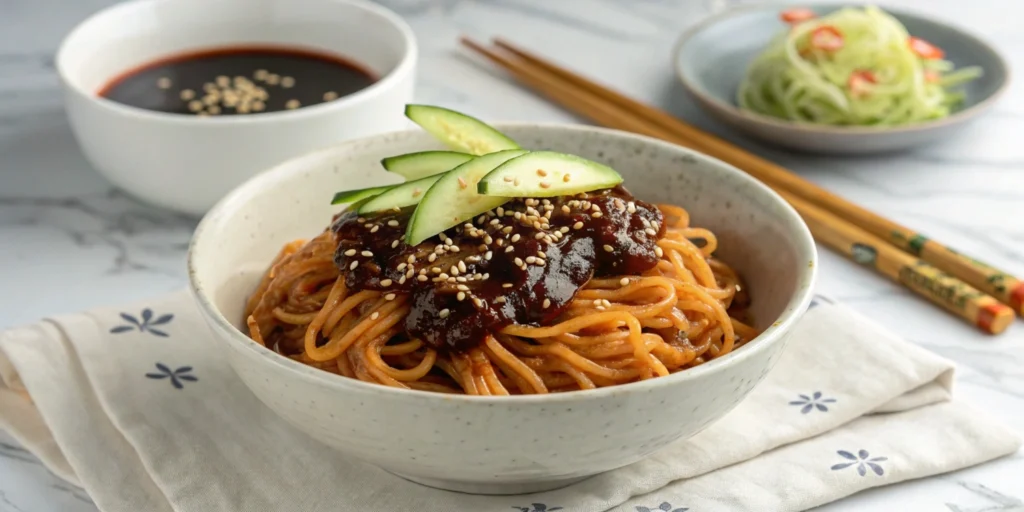
Table of Contents
Cooking Ja Jang Myun (짜장면) is more than just preparing a meal—it’s about connecting with tradition while embracing the joy of creating something extraordinary in your own kitchen. This classic Korean-Chinese noodle dish, with its rich black bean sauce and hearty ingredients, has been a staple in my family for generations. Inspired by my grandmother’s recipe notes, this version is designed to be quick, accessible, and deeply satisfying.
In just 30 minutes, you’ll learn how to prepare this iconic dish, balancing authentic flavors with modern convenience. Let’s dive in!
What Is Ja Jang Myun?
Ja Jang Myun is a celebrated fusion of Korean and Chinese culinary traditions. It features chewy wheat noodles coated in a bold, savory black bean sauce made with chunjang (춘장), a fermented paste that delivers a deep umami kick. Paired with stir-fried pork and vegetables, it’s a comforting and hearty dish that’s become a favorite across generations.
Historically, Ja Jang Myun gained popularity as an affordable comfort food in Korea’s bustling cities, and today, it’s often enjoyed on “Black Day,” a unique Korean holiday where singles gather to savor this dark-hued dish. But you don’t need a special occasion to indulge in this flavorful meal—it’s perfect for any day you want something quick, satisfying, and deeply flavorful.
Essential Ingredients for Authentic Ja Jang Myun
To recreate this dish, gather these essential components:
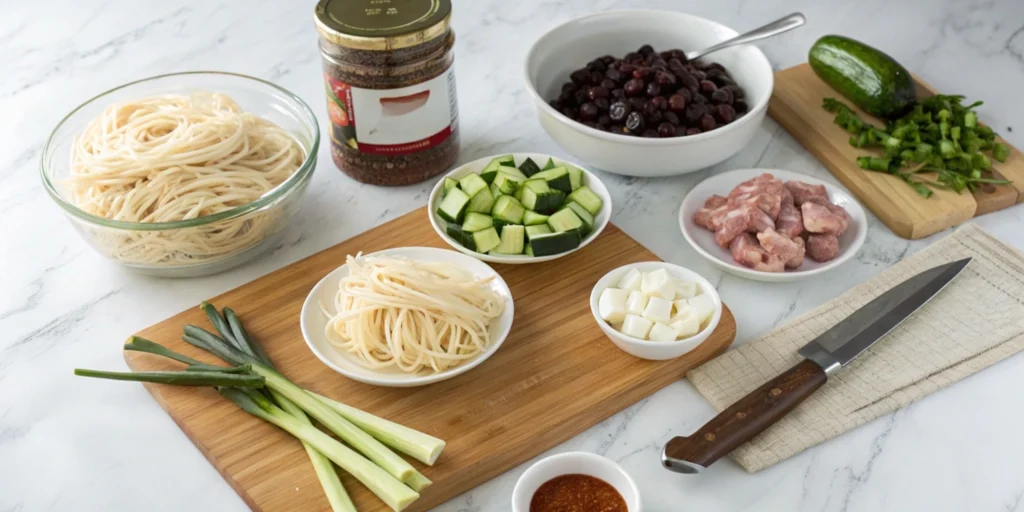
- Wheat Noodles (500g): Opt for thick, fresh noodles for a satisfying chew.
- Chunjang (4 tablespoons): A fermented black bean paste available at most Asian markets.
- Pork Belly (200g): Adds richness and depth; lean ground turkey or chicken can be substituted for a lighter option.
- Onion (1 large): Finely diced to create a sweet and savory base for the sauce.
- Zucchini (1 medium): Adds freshness and balances the sauce’s boldness.
- Potato (1 medium): Diced small for a hearty texture; sweet potato works well as a substitute.
- Sugar (1 tablespoon): Balances the slight bitterness of the black bean paste.
- Cornstarch Slurry (1 tablespoon cornstarch mixed with 2 tablespoons water): Ensures a silky, thickened sauce.
- Sesame Oil (1 teaspoon): Optional, for a nutty aroma and flavor boost.
Step-by-Step Guide to Making Ja Jang Myun
1. Prepare Your Ingredients
- Wash and dice the zucchini, potato, and onion into small cubes.
- Cut the pork belly into bite-sized pieces or prepare your protein substitute.
2. Cook the Noodles
- Bring a large pot of water to a boil and cook the noodles until tender but firm.
- Drain the noodles and briefly rinse them with cold water to halt further cooking, then set them aside.
3. Toast the Chunjang (Black Bean Paste)

- Warm a tablespoon of cooking oil in a wok or frying pan over medium heat.
- Add the chunjang and stir-fry for 1–2 minutes, releasing its aroma and reducing bitterness. Remove and set aside.
4. Stir-Fry the Meat and Vegetables
- Using the same wok, pour in an additional tablespoon of oil. Stir-fry the pork belly until golden and slightly crispy.
- Add the diced onion, zucchini, and potato. Sauté for 5–7 minutes until the vegetables are tender.
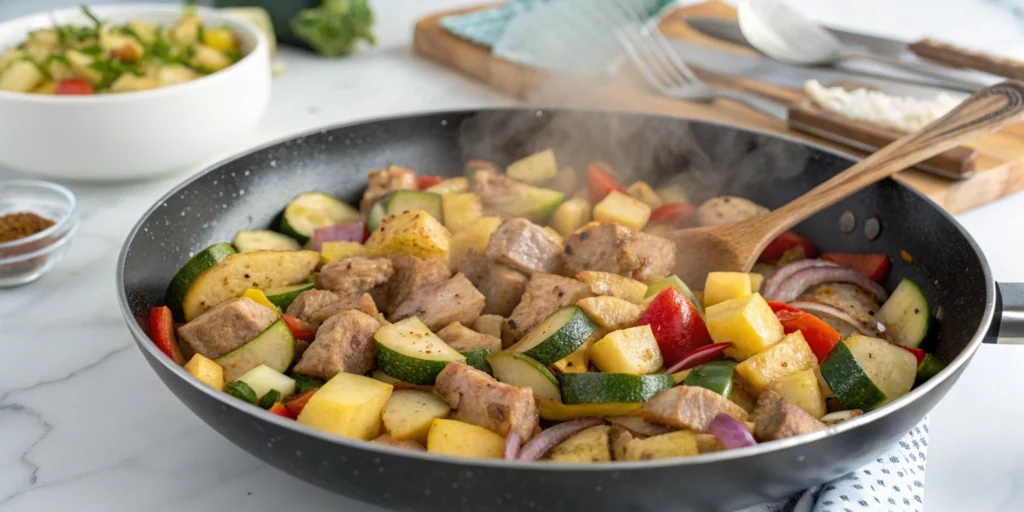
5. Combine and Simmer the Sauce
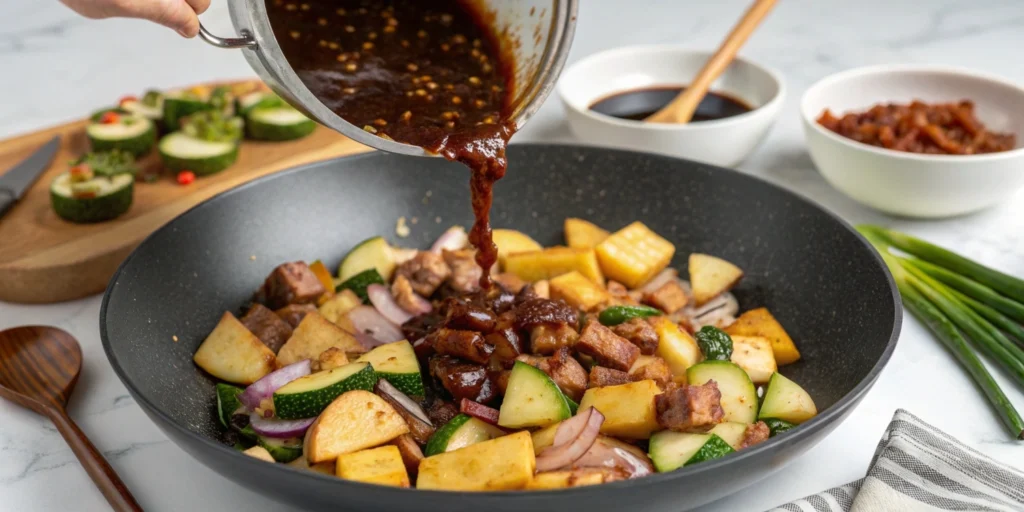
- Return the toasted chunjang to the wok, stirring it into the meat and vegetables.
- Pour in 2 cups of water and bring to a boil, then reduce to a simmer for 10 minutes.
6. Thicken the Sauce
- Slowly add the cornstarch slurry while stirring continuously.
- Watch as the sauce transforms into a glossy, velvety consistency.
7. Assemble and Serve
- Divide the cooked noodles into bowls.
- Ladle the sauce generously over the noodles.
- Garnish with thinly sliced cucumber, sesame seeds, or a drizzle of sesame oil.
Why Ja Jang Myun Stands Out
This recipe excels because it strikes a perfect balance between authenticity and convenience.
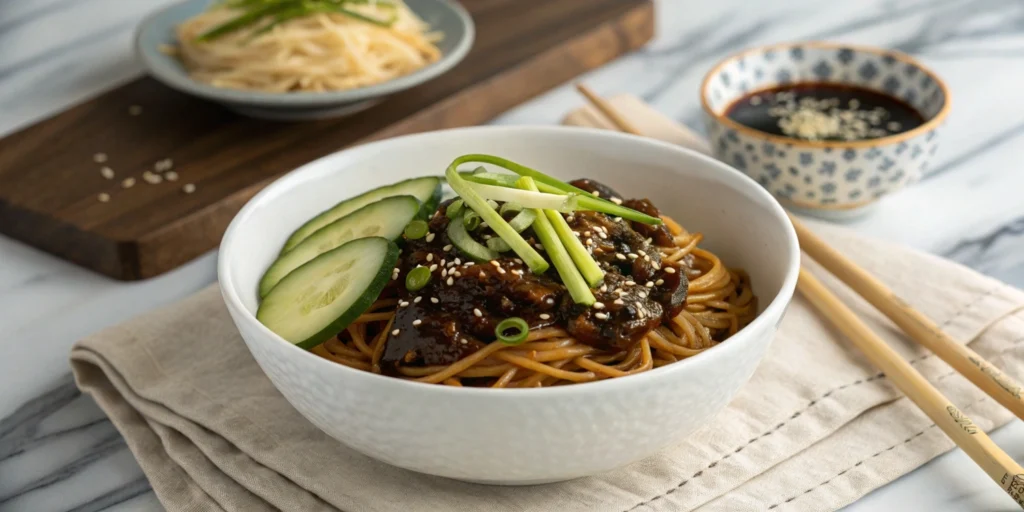
- Speedy Preparation: Ready in just 30 minutes.
- Adaptable: Easily tweakable for dietary needs—use tofu for a vegetarian version or zucchini noodles for a low-carb alternative.
- Family-Friendly: A crowd-pleaser that’s easy to customize.
Health Benefits of Ja Jang Myun
Making Ja Jang Myun at home allows you to elevate its nutritional profile:
- High Fiber Content: Thanks to the vegetables and noodles.
- Rich in Protein: Especially when using lean meats or tofu.
- Fermented Benefits: Chunjang supports gut health through probiotics.
Simple swaps like sweet potatoes for regular potatoes or honey instead of sugar can further enhance its healthiness.
Pro Tips for Perfect Ja Jang Myun
- Toast the Paste: Sautéing chunjang is essential to reduce bitterness and bring out its deep, savory notes.
- Achieve the Right Consistency: The cornstarch slurry is your secret weapon for a silky, clingy sauce.
- Serve Fresh: Ja Jang Myun is best enjoyed immediately after cooking to savor its full flavor.
FAQs About Ja Jang Myun
Q: What does Ja Jang Myun taste like?
A: It’s a savory, slightly sweet, and earthy dish with a rich umami flavor from the black bean paste.
Q: Can Ja Jang Myun be made vegetarian?
A: Absolutely! Substitute pork with tofu or mushrooms for a delicious vegetarian version.
Q: How do I store leftovers?
A: Store the sauce and noodles separately in airtight containers. Store the sauce in an airtight container in the refrigerator, where it will stay fresh for up to three days.
Q: Is Ja Jang Myun spicy?
A: Traditional Ja Jang Myun isn’t spicy, but you can add heat with gochugaru (Korean red pepper flakes) or sliced chilies.
Conclusion: Bringing Tradition to Your Table
With this quick and easy recipe, Ja Jang Myun becomes more than just a dish—it’s a celebration of flavor, history, and the joy of cooking. Following this streamlined version, inspired by my grandmother’s handwritten recipes, you can enjoy the bold and comforting flavors of this iconic meal in no time.
So why wait? Gather your ingredients, roll up your sleeves, and let this recipe transport you to the heart of Korean-Chinese cuisine. Be sure to share your results or any creative twists in the comments below!
